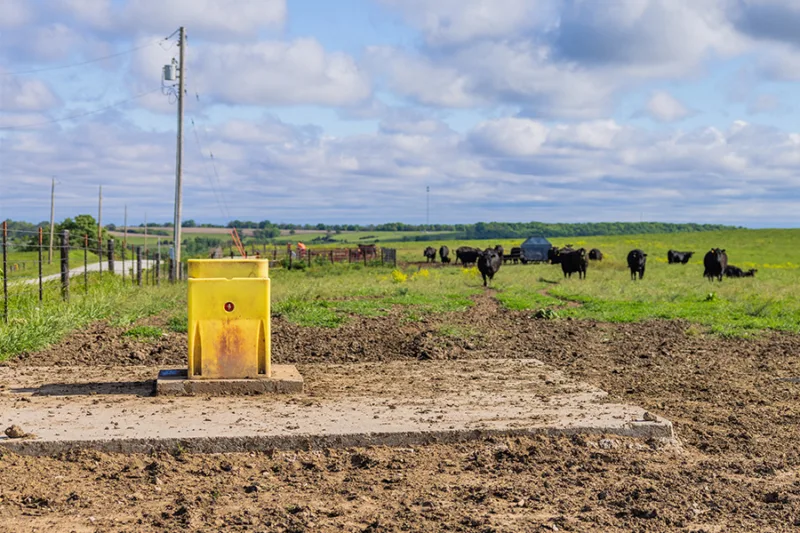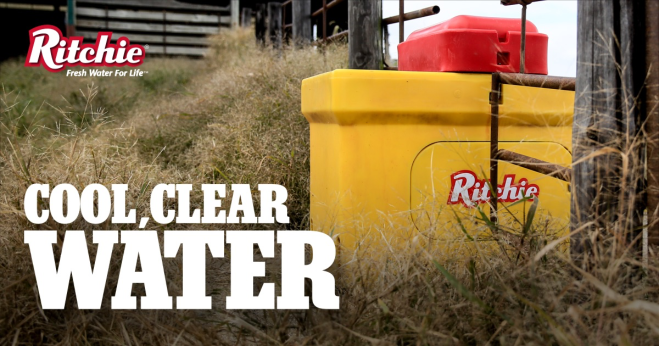WHEN TO UPGRADE TO AUTOMATIC WATERERS
Upgrading to automatic waterers on your operation is a big decision. But it can lead to substantial improvements in livestock health, pasture management and overall profitability. For many producers, the question isn’t if they should switch, but when. We talked to Dave Petty, a cattle producer from Eldora, Iowa, about why he made the transition to Ritchie automatic waterers and how he knew it was time for an upgrade. Read what he had to say about the benefits of upgrading and things you should consider when it’s time to make the move to automatic waterers.
Petty knew it was time for a change when he started noticing uneven grazing and that his herd just wasn’t performing like it should. “Some of my pastures did not have good water sources, which meant that I was overgrazing in some areas and undergrazing in others,” he explained. His cattle were burning extra energy just walking to far-off water, which took a toll on their health and kept them from making the most of the forage around them.
The solution? Installing automatic waterers. “That allowed me to properly graze my pastures without overgrazing, and to also fully utilize some parts of the operation that were not being grazed because of lack of water,” said Petty. Once he saw the difference the automatic waterers were making from a management and animal health standpoint, Petty didn’t think twice about adding more to his system.
Is it time to invest in automatic waterers?
When it comes to deciding whether it’s time to invest in automatic waterers, Petty suggests thinking long-term and asking yourself a few key questions:
Is the investment smart financially, and will it pay for itself over time?
Will it help the environment — like cutting down on water waste or preventing overgrazing in sensitive spots?
Does it make life easier for your crew and bring benefits to the community and the land?
“If it answers those three things to the good side, then I’d go ahead with it,” Petty said. He’s confident this three-part approach — often tied to the pillars of sustainability — is a solid way to guide any big farm investment.
4 telltale signs you’re ready for an upgrade
If you’re still using seasonal setups or open tanks, Petty said there are a few clear signs it might be time to switch to automatic waterers:
Water’s not where it needs to be.
If your water sources aren’t spread out enough, cattle will overgraze near the water and ignore pastures farther away.
Performance is off.
If your herd isn’t hitting gain or body condition score targets, or looking as healthy as they should, limited water access could be the reason.
Cows losing condition.
Cows need to hold their condition to stay healthy and raise strong calves.
You’ve got a gut feeling something’s wrong.
Sometimes you just know. If the herd seems “off,” water access might be the culprit.
Automatic waterers: an investment that pays off
Some people still think automatic waterers are a “nice-to-have,” but the truth is, they’re a smart, money-making investment. Petty gave a lot of reasons why. They allow you to:
- Be ready for any weather. A dependable system keeps water flowing in extreme cold or heat, so you’re not scrambling during a crisis.
- Drought-proof your herd. Even in dry spells, you’ll have steady water, which means you can make the most of your feed resources.
- Save time and labor. No more hauling water or thawing frozen pipes. This frees you and your crew to focus on other important jobs.
- Boost profits and care for the land. Automatic waterers don’t just help your bottom line — they also support good stewardship. With the right water distribution, you can:
- Get the most out of your pastures. Well-placed water means better rotational grazing and quicker forage regrowth.
- Improve forage quality. Moving cattle around lets certain areas rest, so the feed that grows back is higher quality.
- Keep cattle healthier. Healthy animals eat more, convert feed better and bring in better returns.
- Protect soil and grasslands. Even manure distribution builds soil health, while keeping cattle out of sensitive spots prevents erosion and overgrazing.
- Run more sustainably. Better resource use, healthier livestock and a healthier environment all go hand in hand.
Choosing a dependable solution
 When it comes to choosing an automatic waterer, durability and easy maintenance are a must. Petty went with Ritchie because he knew the brand’s reputation and had seen for himself how long they last. “Ritchie has been around for a long time — over a hundred years — and I have noticed from some Ritchie waters that I have had, there’s very little maintenance necessary on them,” he said. He also noted the consistent design and reliability of Ritchie’s components, even in decades-old models, gives him confidence in his decision.
When it comes to choosing an automatic waterer, durability and easy maintenance are a must. Petty went with Ritchie because he knew the brand’s reputation and had seen for himself how long they last. “Ritchie has been around for a long time — over a hundred years — and I have noticed from some Ritchie waters that I have had, there’s very little maintenance necessary on them,” he said. He also noted the consistent design and reliability of Ritchie’s components, even in decades-old models, gives him confidence in his decision.
A smart move for the long haul
For anyone weighing the upfront cost of automatic waterers, they are an investment that can start paying you back sooner than you might think. The boost in production and animal health often shows up fast.
A good automatic waterer is built to last for decades, making it one of the best investments for long-term flexibility and profitability on an operation. Like Petty, you could start with a few units and expand over time as they demonstrate their value.
“It’s a long-term investment, but it’s rather a quick return in profitability,” said Petty.
